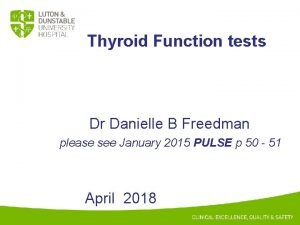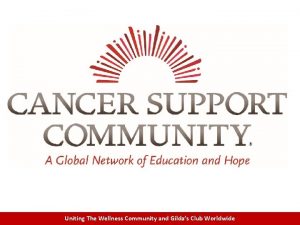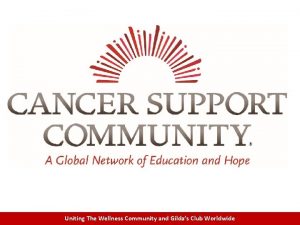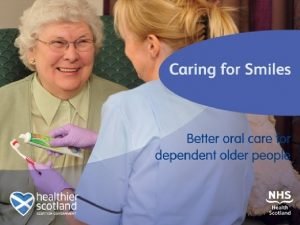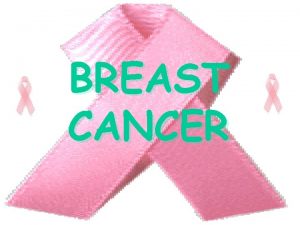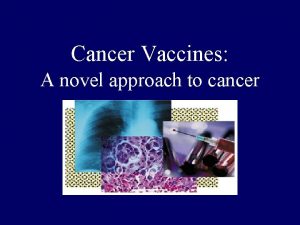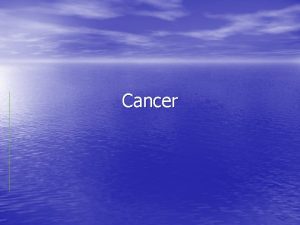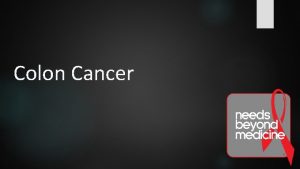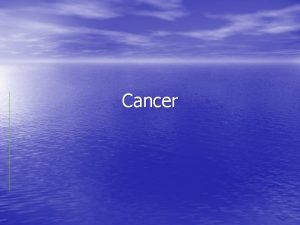Cancer Support for Community Pharmacies Steve Freedman NHS







































- Slides: 39

Cancer Support for Community Pharmacies Steve Freedman NHS Sheffield CCG

What is cancer? • A condition where cells in a specific part of the body grow and reproduce uncontrollably. • The cancerous cells can invade and destroy surrounding healthy tissue, including organs.

The normal cell

Normal cell dividing

Uncontrolled cell growth

Differences between normal and cancer cells Normal cells: 1. Regulated cell division 2. Programmed cell death 3. Respond to external growth and anti-growth signals 4. Balance between blood vessel development and cell need 5. No tissue invasion. Cancer cells: 1. Unregulated cell division 2. Lack programmed cell death 3. Generate own growth signals and insensitive to antigrowth signals 4. New blood vessel growth 5. Tissue invasion and metastasis.

Cancer facts • • • More than 1 in 3 people within their lifetime 309, 500 new cases of cancer per year 1 in 4 deaths in UK due to cancer most over 65 lung, breast, colorectal and prostate account for over half of all cancers in the UK. Reference: Cancer Research UK (2013)

Cancer Incidence (All Cancers)

Potential? • 639 /100, 000 vs 606 /100, 000 • Community Pharmacy Health message

Risk factors for getting cancer Main lifestyle risks: • smoking • being obese • sun/sunbed • alcohol • lack of physical activity Other risk factors • age • genetic • environmental • ethnicity Ref: - World Cancer Research Fund (2007)

Emergency Presentations

Potential? • 25% of cancers diagnosed as emergency presentation (20% national) • Earlier diagnosis needed • Sheffield Pharmacy Screening / Referral

Mortality for All Cancers

Cancer treatments • Surgery • Chemotherapy • Radiotherapy

Cure Rate Comparisons

Surgery • Removal of body tissue • One of main treatments for cancer • 49% of those ‘cured’ of cancer are treated by surgery (Royal College of Radiologists 2003) • The best treatment for cancers that have not spread, leading to better prognosis. Reference: Cancer and its Management, Tobias and Hochhauser (2010)

Implications Can effect: • self-esteem • the way that they are viewed by society • their body image • relationships • lifestyle • employment • sexual relationships • functionality/mobility.

Definition of chemotherapy • Use of drugs for treatment • Cytotoxic chemotherapy • 11% of those ‘cured’ of cancer are treated by chemotherapy (Royal College of Radiologists 2003).

Giving cytotoxic drugs Ways of delivering cytotoxics: • single agent – tends to cause side-effects • Combination – lower doses less side-effects • continuous infusion • Intermittent – enables cell recovery • high dose – used to destroy bone marrow

Side Effects of Cytotoxics Immediate side effects: • pain at the injection site • sensation of cold during administration • itching – along or near path of vein, generalised • hypersensitivity reaction • allergic reaction • leakage of drug into the tissues.

Chemotherapy Other short-term side effects: • hair loss • low blood count • nausea, vomiting • loss of appetite • sore mouth • flu-like symptoms • tiredness, weakness • diarrhoea, constipation • blood in urine • discoloured urine.

Radiotherapy • Radiotherapy is the use of high energy Xrays and similar rays (such as electrons) to cause damage to cells, which then makes it difficult for them to replicate. • 40% of those ‘cured’ of cancer are treated by radiotherapy. (Royal College of Radiologists 2003)

How radiotherapy is given • Single Dose or Daily Dose • Daily treatments where total dose is split into fractions to preserve normal tissue and reduce side effects of treatment.

Effects of radiotherapy • Affects both normal and cancer cells • Aim to preserve normal cells and damage only cancer cells • Normal tissue repairs more effectively • An area treated with radiotherapy usually receives a lifetime dose.

Radiotherapy: short-term side effects • • • fatigue malnutrition weight loss skin: redness/sunburn-like symptoms head and neck: irritation of mucosal lining, dryness, ulceration • chest: heartburn-like symptoms if oesophagus is affected • upper abdomen: nausea and vomiting • lower abdomen: cramps, diarrhoea and urinary problems.

Late Effects INCREASED SURVIVORSHIP INCREASED LATE EFFECTS

Late Effects Defined as: consequences of cancer and its treatment that manifest either during or after cancer treatment and persist beyond the end of treatment

Treatment consequences (long-term/late effects) Physical Functional e. g. stomas amputation Psychological e. g. anxiety depression

Risk for Late Effects • Risk for late effects: – Cancer therapy – Age at treatment – Gender – Co-morbid health conditions – Genetic factors – Lifestyle factors

Living With And Beyond Cancer

New Support • ‘Hidden cohort’ of patients • Undergoing or recently completed radiation therapy or chemotherapy • Care closer to home • Improved patient outcomes • Utilising clinical skills of pharmacist

Telephone Triage • WPH triage patients • Referral to Pharmacy • Pharmacies to ensure familiarity with monographs • Not Minor Ailments to this cohort • Living With And Beyond Cancer!

New Conditions • • • LWABC Constipation LWABC Dry Mouth LWABC Dry Skin LWABC Eye Irritation LWABC Skin Inflammation LWABC Sore Mouth

New Products Dry Mouth • Bio. Xtra® Gel Spray (50 ml) • Bio. Xtra® Moisturising Gel (40 ml) • Salivix® Pastilles (50) • Xerotin® Oral Spray (100 ml) Constipation • Docusate Sodium 100 mg Capsules (30) (Dioctyl®) • Docusate Sodium 50 mg/5 ml (300 ml)(Docusol®) • Bisacodyl

Red Flag Symptoms • Temperatures of 37. 5 o. C or more • Symptoms of infection • Feeling generally unwell • Bleeding or bruising • • • Nausea and vomiting Diarrhoea Chest pains Breathlessness Neuro-sensory changes

Red Flag Symptoms Contacts for ‘Red Flag’ patients: • Cancer team or radiotherapy department (226 5282) at WPH or • Cancer Information and Support Centre (226 5391)

Resources

Contacts Louise Metcalfe Steve Freedman Macmillian Primary Care Quality Lead Nurse 305 1077 Louise. metcalfe 4@nhs. net Community Pharmacy Lead Pharmacist 305 1129 steve. freedman@nhs. net

Any Questions?
 Type of community pharmacy
Type of community pharmacy Steve freedman
Steve freedman Aktiv expektans
Aktiv expektans Downstream entity examples
Downstream entity examples Accounting for pharmacies
Accounting for pharmacies Steve jobs with cancer
Steve jobs with cancer Steve curtis cancer
Steve curtis cancer Lsf nhs
Lsf nhs Steve jobs, steve wozniak, and ronald wayne
Steve jobs, steve wozniak, and ronald wayne Young and freedman
Young and freedman Current resistance and electromotive force
Current resistance and electromotive force Capacitncia
Capacitncia Danielle freedman
Danielle freedman Rabbi david freedman
Rabbi david freedman Slidetodoc
Slidetodoc 461 enneagram
461 enneagram Csci 330
Csci 330 Avi freedman
Avi freedman Avi freedman net worth
Avi freedman net worth Nhs community pharmacy contractual framework
Nhs community pharmacy contractual framework Example of major point
Example of major point Community support options
Community support options Wireless config analyzer express
Wireless config analyzer express Ucsm
Ucsm Formuö
Formuö Typiska novell drag
Typiska novell drag Nationell inriktning för artificiell intelligens
Nationell inriktning för artificiell intelligens Returpilarna
Returpilarna Varför kallas perioden 1918-1939 för mellankrigstiden?
Varför kallas perioden 1918-1939 för mellankrigstiden? En lathund för arbete med kontinuitetshantering
En lathund för arbete med kontinuitetshantering Kassaregister ideell förening
Kassaregister ideell förening Personlig tidbok fylla i
Personlig tidbok fylla i Sura för anatom
Sura för anatom Vad är densitet
Vad är densitet Datorkunskap för nybörjare
Datorkunskap för nybörjare Tack för att ni lyssnade bild
Tack för att ni lyssnade bild Debatt artikel mall
Debatt artikel mall Autokratiskt ledarskap
Autokratiskt ledarskap Nyckelkompetenser för livslångt lärande
Nyckelkompetenser för livslångt lärande Påbyggnader för flakfordon
Påbyggnader för flakfordon












